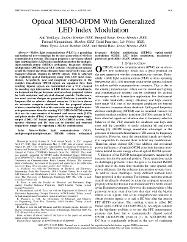Optical MIMO-OFDM With Generalized LED Index Modulation
Access
info:eu-repo/semantics/openAccessDate
2017Author
Yeşilkaya, AnılBasar, Ertugrul
Miramirkhani, Farshad
Panayırcı, Erdal
Uysal, Murat
Haas, Harald
Metadata
Show full item recordAbstract
Visible light communications (VLC) is a promising and uncharted new technology for the next generation of wireless communication systems. This paper proposes a novel generalized light emitting diode (LED) index modulation method for multiple-input-multiple-output (MIMO) orthogonal frequency division multiplexing (OFDM)-based VLC systems. The proposed scheme avoids the typical spectrum efficiency losses incurred by time- and frequency-domain shaping in OFDM signals. This is achieved by exploiting spatial multiplexing along with LED index modulation. Accordingly real and imaginary components of the complex time-domain OFDM signals are separated first then resulting bipolar signals are transmitted over a VLC channel by encoding sign information in LED indexes. As a benchmark we demonstrate the performance analysis of our proposed system for both analytical and physical channel models. Furthermore two novel receiver designs are proposed. Each one is suitable for frequency-flat or selective channel scenarios. It has been shown via extensive computer simulations that the proposed scheme achieves considerably better bit error ratio versus signal-to-noise-ratio performance than the existing VLC-MIMO-OFDM systems that use the same number of transmit and receive units [LEDs and photo diodes (PDs)]. Compared with the single-input single-output (SISO) DC biased optical (DCO)-OFDM system both spectral efficiency and DC bias can be doubled and removed respectively simply by exploiting a MIMO configuration.
















